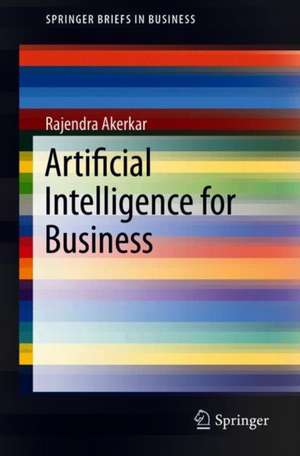Artificial Intelligence for Business: SpringerBriefs in Business
Autor Rajendra Akerkaren Limba Engleză Paperback – 20 aug 2018
Din seria SpringerBriefs in Business
-
 Preț: 316.75 lei
Preț: 316.75 lei -
 Preț: 262.86 lei
Preț: 262.86 lei -
 Preț: 382.75 lei
Preț: 382.75 lei -
 Preț: 410.39 lei
Preț: 410.39 lei -
 Preț: 380.25 lei
Preț: 380.25 lei -
 Preț: 414.21 lei
Preț: 414.21 lei -
 Preț: 341.97 lei
Preț: 341.97 lei -
 Preț: 476.95 lei
Preț: 476.95 lei -
 Preț: 342.74 lei
Preț: 342.74 lei -
 Preț: 380.25 lei
Preț: 380.25 lei -
 Preț: 385.84 lei
Preț: 385.84 lei -
 Preț: 343.98 lei
Preț: 343.98 lei -
 Preț: 378.54 lei
Preț: 378.54 lei -
 Preț: 375.45 lei
Preț: 375.45 lei -
 Preț: 443.75 lei
Preț: 443.75 lei -
 Preț: 444.74 lei
Preț: 444.74 lei -
 Preț: 476.03 lei
Preț: 476.03 lei -
 Preț: 379.48 lei
Preț: 379.48 lei -
 Preț: 340.83 lei
Preț: 340.83 lei -
 Preț: 377.18 lei
Preț: 377.18 lei -
 Preț: 345.50 lei
Preț: 345.50 lei -
 Preț: 376.43 lei
Preț: 376.43 lei -
 Preț: 378.12 lei
Preț: 378.12 lei -
 Preț: 345.45 lei
Preț: 345.45 lei -
 Preț: 343.97 lei
Preț: 343.97 lei -
 Preț: 376.59 lei
Preț: 376.59 lei -
 Preț: 341.64 lei
Preț: 341.64 lei -
 Preț: 341.75 lei
Preț: 341.75 lei -
 Preț: 344.14 lei
Preț: 344.14 lei -
 Preț: 377.18 lei
Preț: 377.18 lei -
 Preț: 377.95 lei
Preț: 377.95 lei -
 Preț: 343.72 lei
Preț: 343.72 lei -
 Preț: 374.08 lei
Preț: 374.08 lei -
 Preț: 375.23 lei
Preț: 375.23 lei -
 Preț: 375.62 lei
Preț: 375.62 lei -
 Preț: 376.43 lei
Preț: 376.43 lei -
 Preț: 377.73 lei
Preț: 377.73 lei -
 Preț: 376.22 lei
Preț: 376.22 lei -
 Preț: 347.32 lei
Preț: 347.32 lei -
 Preț: 376.59 lei
Preț: 376.59 lei -
 Preț: 376.22 lei
Preț: 376.22 lei -
 Preț: 343.72 lei
Preț: 343.72 lei -
 Preț: 383.12 lei
Preț: 383.12 lei -
 Preț: 376.22 lei
Preț: 376.22 lei -
 Preț: 374.85 lei
Preț: 374.85 lei -
 Preț: 346.86 lei
Preț: 346.86 lei -
 Preț: 376.22 lei
Preț: 376.22 lei -
 Preț: 342.74 lei
Preț: 342.74 lei -
 Preț: 377.73 lei
Preț: 377.73 lei -
 Preț: 379.09 lei
Preț: 379.09 lei
Preț: 461.22 lei
Preț vechi: 542.62 lei
-15% Nou
Puncte Express: 692
Preț estimativ în valută:
88.28€ • 95.93$ • 74.21£
88.28€ • 95.93$ • 74.21£
Carte tipărită la comandă
Livrare economică 21 aprilie-05 mai
Preluare comenzi: 021 569.72.76
Specificații
ISBN-13: 9783319974354
ISBN-10: 3319974351
Pagini: 100
Ilustrații: XI, 81 p. 7 illus. in color.
Dimensiuni: 155 x 235 mm
Greutate: 0.15 kg
Ediția:1st ed. 2019
Editura: Springer International Publishing
Colecția Springer
Seria SpringerBriefs in Business
Locul publicării:Cham, Switzerland
ISBN-10: 3319974351
Pagini: 100
Ilustrații: XI, 81 p. 7 illus. in color.
Dimensiuni: 155 x 235 mm
Greutate: 0.15 kg
Ediția:1st ed. 2019
Editura: Springer International Publishing
Colecția Springer
Seria SpringerBriefs in Business
Locul publicării:Cham, Switzerland
Cuprins
Chapter 1: Introduction to Artificial Intelligence.- Chapter 2: Machine Learning.- Chapter 3: Deep Learning.- Chapter 4: Recommendation Engines.- Chapter 5: Natural Language Processing.- Chapter 6: Employing AI in Business.
Notă biografică
Rajendra Akerkar holds master’s in applied mathematics and doctorate in computer science. He is a professor of Information Technology at Vestlansforsking (Western Norway Research Institute), Norway. He leads big data research group at the institute. His research and teaching experience, in artificial intelligence and related subjects, includes over 26 years in the Academia spanning universities in Asia, Europe and North America. Rajendra received prestigious BOYSCASTS Young Scientist award of Department of Science & Technology, Government of India, in 1997. He was UNESCO‐TWAS Associate Professor from 1998‐2001. He is an editor‐in‐chief of International Journal of Computer Science & Applications, and also an associate editor of International Journal of Metadata, Semantics and Ontologies and Knowledge Management Track Editor of Web Intelligence, an international journal. His research focuses on application of big data methods to business challenges, and social media analysis in a wide set of semantic dimensions. He currently coordinating projects funded by Research Council of Norway and EU-funded Horizon 2020 programme. He is actively involved in several international ICT initiatives for more than 21 years.
Textul de pe ultima copertă
This book offers a practical guide to artificial intelligence (AI) techniques that are used in business. The book does not focus on AI models and algorithms, but instead provides an overview of the most popular and frequently used models in business. This allows the book to easily explain AI paradigms and concepts for business students and executives. Artificial Intelligence for Business is divided into six chapters. Chapter 1 begins with a brief introduction to AI and describes its relationship with machine learning, data science and big data analytics. Chapter 2 presents core machine learning workflow and the most effective machine learning techniques. Chapter 3 deals with deep learning, a popular technique for developing AI applications. Chapter 4 introduces recommendation engines for business and covers how to use them to be more competitive. Chapter 5 features natural language processing (NLP) for sentiment analysis focused on emotions. With the help of sentiment analysis, businesses can understand their customers better to improve their experience, which will help the businesses change their market position. Chapter 6 states potential business prospects of AI and the benefits that companies can realize by implementing AI in their processes.
Caracteristici
Offers an overview of the most popular artificial intelligence techniques used in business Explains how to select and execute artificial intelligence procedures for business purposes including predictions, segmentation and natural language processing Presents observations and insight on employing AI solutions in business.
